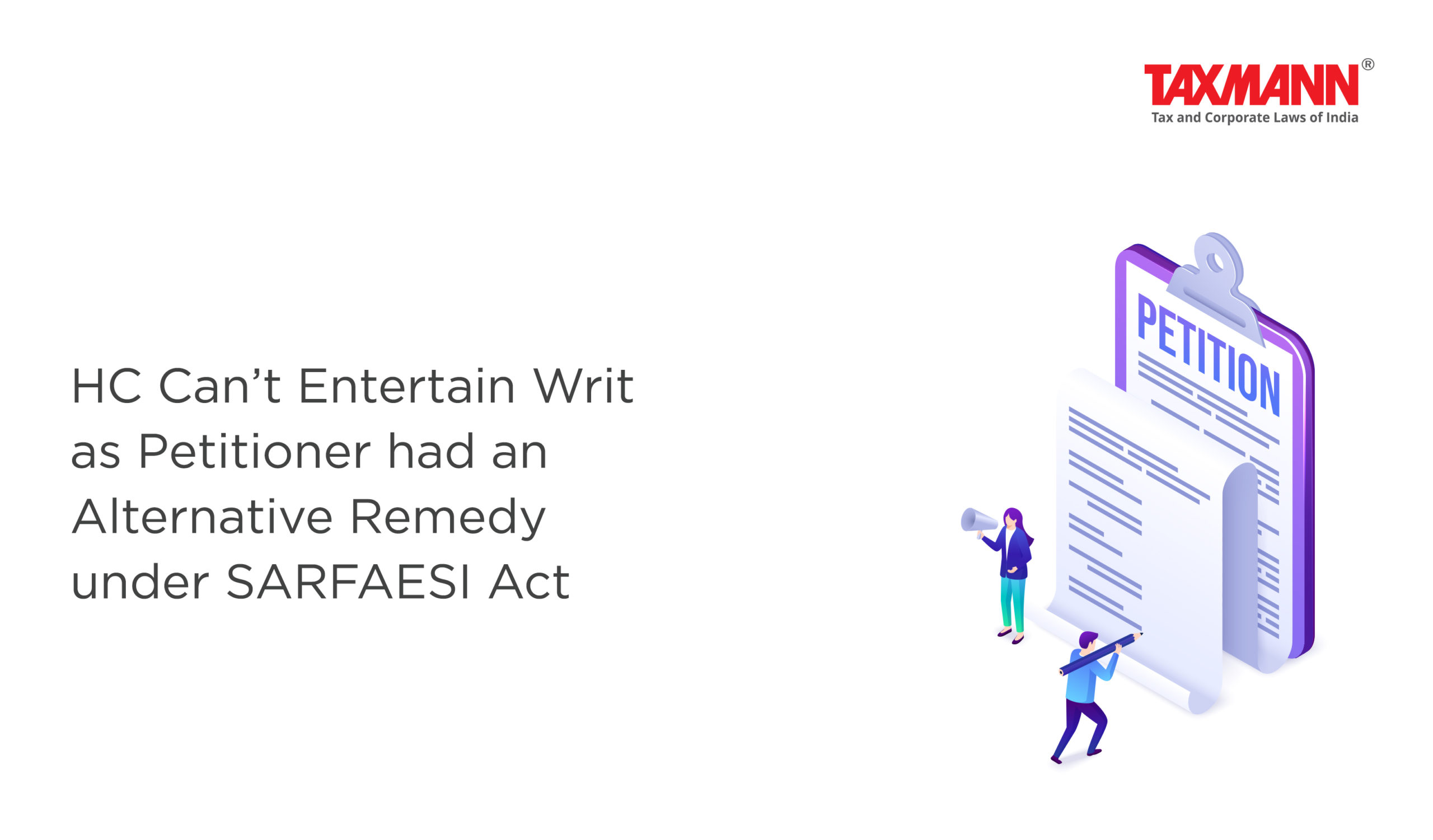HC Can’t Entertain Writ as Petitioner had an Alternative Remedy under SARFAESI Act
- Blog|News|FEMA & Banking|
- 3 Min Read
- By Taxmann
- |
- Last Updated on 27 May, 2023

Case Details: Yaddala Kriashnaveni v. State Bank of India - [2023] 150 taxmann.com 195 (HC-Andhra Pradesh)
Judiciary and Counsel Details
-
- D.V.S.S. Somayajulu & V. Srinivas, JJ.
Facts of the Case
In the instant case, the borrower availed loan from the respondent bank. In order to secure the said loan, the borrower mortgaged its immovable properties. Meanwhile, the borrower died. The bank issued a notice to the petitioner, who is the legal heir of the deceased borrower under sections 13(2) and 13(3) of the Securitisation and Reconstruction of Financial Assets and Enforcement of Security Interest Act, 2002 (SARFAESI Act).
However, the petitioner failed to make any payment. As a result, the bank approached the District Magistrate under section 14 to seek assistance in taking possession of the said properties, which was allowed by the District Magistrate.
The petitioner claimed that he had independent rights over the said property through the settlement deed and argued that the alleged mortgage for which the notice was issued, occurred long after the said settlement deed was executed.
Further, the petitioner contended that Section 14 of the SARFAESI Act imposes a mandatory duty on the respondent’s bank to issue a proper notice containing the details that are necessary and more particularly under section 14(1a)(i) to (ix) of the SARFAESI Act.
Consequently, the petitioner filed an instant writ seeking a declaration that the action initiated by the bank under section 14 was illegal, arbitrary and against the provisions of the Act.
It was noted that as per Section 13(2) of the Act, a notice must be issued to the borrower, requiring him to discharge in full his liability within 60 days from the date of the notice. If the borrower fails to do so, the secured creditor shall be entitled to exercise all or any of the rights mentioned under sub-section 4 of the Act.
Sub-section 4 of the Act states that in case the borrower fails to discharge his liability in full within the specified period in sub-section 2, the secured creditor may take recourse to any of the following measures:
(a) take possession of the secured assets of the borrower including the right to transfer by way of lease, assignment or sale for realising the secured asset;
(b) take over the management of the business of the borrower including the right to transfer by way of lease, assignment or sale for realising the secured asset.
Thus, the SARFAESI Act mandates a 60 days period as the upper limit for raising an objection and also for paying the amount.
Further, it was noted that section 13(3A) of the SARFAESI Act clearly states that the borrower shall make an objection immediately after the receipt of a notice and that the Bank was right in stating that no objection as mandated by the Act, has been made.
However, in the instant case, the petitioner did not make any representation or raise any objection within the 60 days window, and it was only after almost 7 months, the petitioner raised objections and, thus, did not meet the mandatory requirement under section 13(3) and 13(4) of the Act.
High Court Held
The High Court held that the petitioner having title deed to the property and settlement deed being prior to the alleged mortgage etc, were questions of facts which could not be gone into in instant writ. The appropriate remedy for the same was elsewhere. Thus, the instant writ was not maintainable and was to be dismissed.
List of Cases Referred to
-
- Kosuri Babu v. Union of India 2020 SCC Online AP 1808 (para 4)
- Standard Chartered Bank v. Noble Kumar [2013] 37 taxmann.com 305/122 SCL 124 (SC)/9 SCC 620 (para 5)
- Taylor v. Taylor [1875] 1 Ch. D. 426 (para 12)
- Shiv Kumar Chanda v. Municipal Corporation of Delhi [1993] 3 SCC 161 (para 12)
- C. Bright v. District Collector [2020] 121 taxmann.com 67/[2021] 163 SCL 573 (SC) (para 14).
Disclaimer: The content/information published on the website is only for general information of the user and shall not be construed as legal advice. While the Taxmann has exercised reasonable efforts to ensure the veracity of information/content published, Taxmann shall be under no liability in any manner whatsoever for incorrect information, if any.

Taxmann Publications has a dedicated in-house Research & Editorial Team. This team consists of a team of Chartered Accountants, Company Secretaries, and Lawyers. This team works under the guidance and supervision of editor-in-chief Mr Rakesh Bhargava.
The Research and Editorial Team is responsible for developing reliable and accurate content for the readers. The team follows the six-sigma approach to achieve the benchmark of zero error in its publications and research platforms. The team ensures that the following publication guidelines are thoroughly followed while developing the content:
- The statutory material is obtained only from the authorized and reliable sources
- All the latest developments in the judicial and legislative fields are covered
- Prepare the analytical write-ups on current, controversial, and important issues to help the readers to understand the concept and its implications
- Every content published by Taxmann is complete, accurate and lucid
- All evidence-based statements are supported with proper reference to Section, Circular No., Notification No. or citations
- The golden rules of grammar, style and consistency are thoroughly followed
- Font and size that’s easy to read and remain consistent across all imprint and digital publications are applied



 CA | CS | CMA
CA | CS | CMA
